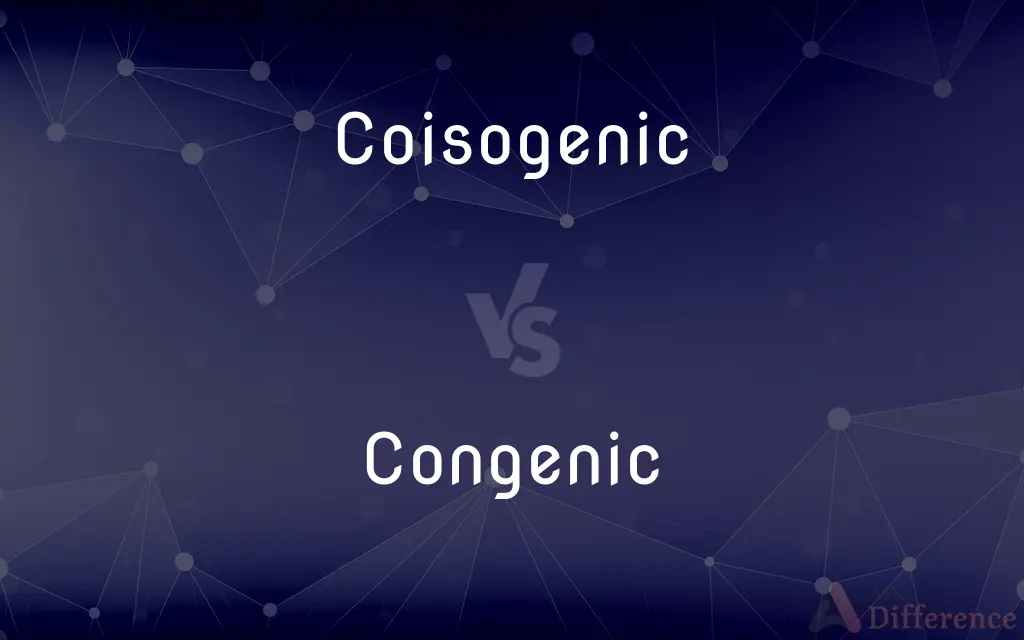Coisogenic vs. Congenic — What's the Difference?
Edited by Tayyaba Rehman — By Urooj Arif — Updated on April 9, 2024
Coisogenic strains are genetically identical except for a single mutation, while congenic strains involve the transfer of a gene segment from one strain to another.

Difference Between Coisogenic and Congenic
Table of Contents
ADVERTISEMENT
Key Differences
Coisogenic strains are developed through a precise genetic modification, introducing a single gene mutation into an otherwise genetically identical organism. This process highlights the effects of a specific gene alteration. On the other hand, congenic strains are created by transferring a specific gene or gene segment from one strain into another, maintaining the background genetic makeup. This method is often used to study the effects of particular genes or loci on various phenotypes.
The creation of coisogenic strains typically involves targeted mutagenesis or gene editing techniques such as CRISPR-Cas9, allowing for the precise alteration of a single gene. Whereas, the development of congenic strains usually requires selective breeding over many generations to ensure that only the desired gene segment is transferred, making it a more time-consuming process.
Coisogenic strains are particularly valuable in research for studying the impact of single-gene mutations, offering a clear comparison between mutant and wild-type phenotypes. In contrast, congenic strains are useful for understanding the contributions of specific genetic loci to complex traits and diseases, by comparing strains that differ only in the targeted gene segment.
One key advantage of using coisogenic strains is their ability to provide definitive evidence about the role of specific mutations in biological processes or diseases, due to the minimal genetic variation. Conversely, congenic strains are advantageous for dissecting genetic contributions to multifactorial traits, as they allow researchers to isolate the effect of a particular genetic region within a consistent genetic background.
While coisogenic strains are ideal for studying the effects of single-gene mutations, their utility is somewhat limited by the fact that many traits and diseases are influenced by multiple genes and environmental factors. Congenic strains, on the other hand, offer a broader scope for research into complex genetic interactions but require a significant investment of time and resources to develop.
ADVERTISEMENT
Comparison Chart
Definition
Strains genetically identical except for a single specified mutation.
Strains with a specific gene or gene segment transferred into another strain.
Creation Method
Targeted mutagenesis or gene editing (e.g., CRISPR-Cas9).
Selective breeding over multiple generations.
Research Use
Studying the impact of single-gene mutations.
Studying specific genetic loci's contribution to traits or diseases.
Advantages
Precise analysis of single-gene effects.
Useful for complex traits and genetic interactions.
Limitations
Limited to single-gene influences.
Time-consuming and resource-intensive development.
Compare with Definitions
Coisogenic
A coisogenic strain is a type of GMO where only one gene has been altered.
A coisogenic mouse model may be used to study the specific impact of a gene mutation on diabetes.
Congenic
Involves transferring a gene or gene segment from one strain to another through selective breeding.
A congenic rat strain might be developed to study hypertension by transferring a specific gene segment associated with blood pressure regulation.
Coisogenic
Characterized by the introduction of a single genetic mutation.
Creating a coisogenic strain involves altering a single, specific gene in an organism's genome.
Congenic
Their development requires extensive time and resources.
Developing congenic strains can take several years of selective breeding and genotyping.
Coisogenic
Used extensively in genetic research to understand gene function.
Coisogenic strains have clarified the role of certain genes in immune response.
Congenic
Characterized by the introduction of a gene segment into a different genetic background.
By creating congenic strains, scientists can study how a gene segment from one mouse strain affects another strain's phenotype.
Coisogenic
Provides a direct comparison to the original, unmodified strain.
Researchers compare coisogenic and wild-type strains to observe mutation effects.
Congenic
Maintains the recipient strain's genetic background, except for the introduced segment.
Congenic strains allow for the effects of specific genes to be observed without background genetic noise.
Coisogenic
Except for the mutation, they are genetically identical to the parent strain.
Coisogenic strains ensure genetic consistency, highlighting the mutation's effects.
Congenic
Useful for analyzing the genetic basis of complex traits.
Congenic strains help dissect the genetic components of multifactorial diseases like cancer.
Coisogenic
(genetics) Genetically identical to an inbred strain except for a mutation at a specific locus.
Congenic
In genetics, two organisms that differ in only one locus and a linked segment of chromosome are defined as congenic. Similarly, organisms that are coisogenic differ in one locus only and not in the surrounding chromosome.
Congenic
(genetics) (of different strains of an organism) That are genetically identical except for a variation in a limited genetic region or locus
Congenic
Such an organism
Common Curiosities
What makes congenic strains valuable for genetic research?
They allow for the isolation and study of the effects of specific genetic regions within a consistent background.
How are coisogenic strains created?
They're created through targeted mutagenesis or gene editing techniques, such as CRISPR-Cas9.
Can coisogenic strains be used to study complex diseases?
While useful for single-gene studies, coisogenic strains are less suitable for complex diseases influenced by multiple genes.
Can congenic strains help in understanding gene-environment interactions?
Yes, by isolating the effect of specific genes, they can help in studying how these genes interact with environmental factors.
What advantage do coisogenic strains have over congenic strains?
Coisogenic strains provide a clearer understanding of single-gene effects due to minimal genetic variation.
How do congenic and coisogenic strains differ in their creation?
Coisogenic strains are created through precise gene editing, while congenic strains result from selective breeding.
What is a key limitation of using coisogenic strains for research?
Their application is limited to the study of single-gene mutations.
Why are congenic strains considered resource-intensive?
Their development requires extensive breeding and genotyping efforts over several years.
In what way do coisogenic strains offer direct comparison in research?
They allow researchers to compare mutated strains directly with their wild-type counterparts to observe specific gene effects.
What is the significance of maintaining the genetic background in congenic strains?
It ensures that any observed phenotypic differences are due to the transferred gene segment, not other genetic variations.
What distinguishes a coisogenic strain from a congenic strain?
Coisogenic strains differ by a single mutation, whereas congenic strains have a specific gene or gene segment transferred from one strain to another.
What is the primary use of congenic strains in research?
Congenic strains are used to study the effects of specific genetic loci on traits and diseases.
Are coisogenic strains genetically identical to their parent strain?
Yes, except for the specific mutation introduced, they are genetically identical.
Is the development of congenic strains time-consuming?
Yes, it involves selective breeding over many generations and is resource-intensive.
Share Your Discovery

Previous Comparison
Exacerbate vs. Alleviate
Next Comparison
Argument vs. FallacyAuthor Spotlight
Written by
Urooj ArifUrooj is a skilled content writer at Ask Difference, known for her exceptional ability to simplify complex topics into engaging and informative content. With a passion for research and a flair for clear, concise writing, she consistently delivers articles that resonate with our diverse audience.
Edited by
Tayyaba RehmanTayyaba Rehman is a distinguished writer, currently serving as a primary contributor to askdifference.com. As a researcher in semantics and etymology, Tayyaba's passion for the complexity of languages and their distinctions has found a perfect home on the platform. Tayyaba delves into the intricacies of language, distinguishing between commonly confused words and phrases, thereby providing clarity for readers worldwide.
















































